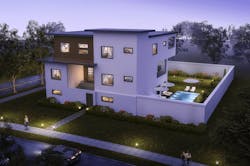As natural disasters rip across the globe with unprecedented force, homeowners are increasingly looking for ways to fortify their homes. One solution comes in the form of a 3D cementitious panel by Re-Structure Group that won the 2019 NAHB Global Innovation Award for its weather resistance and energy efficiency.
From deadly tornadoes in the Great Plains to more frequent destructive wildfires on the West Coast, dangers of climate change are mounting, says the latest report from the Intergovernmental Panel on Climate Change. But RSG 3-D reinforced panel systems offer a protective barrier. CEO Ken Calligar believes the system represents the future of residential and commercial construction, and that growing consumer interest in his product will help usher in a new era of durable green building products and practices.
PRO BUILDER: What is the RSG 3-D building system and what makes it different?
Ken Calligar: At RSG 3-D, we’ve developed one of the strongest building systems in the world over the past 25 years. It’s steel plus concrete with expanded polystyrene in the center, and within every panel is a truss system that repeats every 8 inches. It can withstand 300 mph winds and 11.0 Richter scale [seismic] events—though there has never been a quake of that magnitude.
Our systems are also hurricane-proof and fireproof because of the concrete skin. In addition, the system is extremely energy efficient because of its continuous insulation and because the concrete on the inside essentially acts as a thermos by taking on the temperature in the room. You use 50% of the energy to condition the building, getting you halfway to zero net energy no matter where you start. A small solar array will get you the rest of the way.
You also don’t get sick building syndrome with RSG 3-D because there’s nothing to rot, mold, or leak, and with concrete, you can’t get vermin, insects, hornets, or squirrels living in your walls.
PB: Tell us about the expansion of RSG 3-D in both the residential and commercial sectors.
KC: We have every manner of building in the world. We have condos on the beach in Grand Cayman as well as commercial buildings, LEED Gold municipal buildings, buildings on the campus of the University of California, and prisons in Georgia. We even supplied the U.S. Army in Iraq and Afghanistan and received good NATO ballistic ratings on our structures. Our California projects are also getting a lot of attention right now because we’ve survived wildfires there; we achieved a 2-to-4-hour flame rating on the wall systems. The box works in a thousand ways.
RELATED
- Veev’s Amit Haller on Scaling Innovation and Shortening the Supply Chain
- Vaughan Buckley on Restarting a Former Katerra Factory
- The Great Convergence: Why the Movement to Off-Site Construction Is Happening Now
PB: What are some of your construction solutions for the future, especially as they relate to affordable housing?
KC: In January 2020, we won an NAHB Global Innovation award, and it wasn’t really for the panel. It was for using the panel for affordable housing. It’s ironic in that sense: I can take the safest wall system in the world and deliver it down to a 300-square-foot studio. It’s also pretty easy to do because the system essentially works like adult-sized Lego blocks. We’re creating simplified building solutions for the future of the industry.
RSG 3-D takes the insulation of a SIP, adds the durability of a SCIP, and then puts a structure within it. Disaster resilience comes about because of a building’s skin. The combination of concrete and panel in the truss system gives it a lot of strength.
RSG 3-D structures are not only faster to build but are also less labor-intensive, to the point where we account for 5% to 10% of a home’s total budget for a 500-year building. Operating costs never go up because RSG 3-D homeowners have no energy needs. You have complete durability with no maintenance, so it builds generational wealth.
PB: The expansion of sustainable building still seems to be an up-and-coming practice. What would you say to builders still hesitant to make the switch from traditional materials to new eco-friendly innovations?
KC: The unofficial answer is get on board or get run over. It's all coming. California energy codes are coming east. They’re in Austin, they're in Denver, and that's all net zero net. The industry is very slow to change, but guess what? You don't have a choice. And your consumers want resilience.
PB: How do panel products hold up in major seismic events or extreme weather?
KC: We did a life cycle assessment of products back in 2016, and our findings showed that structural insulated panels [SIPs] are great for insulation, and structural concrete insulated panels [SCIPs, aka insulated concrete forms or ICFs] are great for durability.
RSG 3-D takes the insulation of a SIP, adds the durability of a SCIP, and then puts a structure within it. Disaster resilience comes about because of a building’s skin. The combination of concrete and panel in the truss system gives it a lot of strength. We did 3 1/2 years of testing at the University of California, Irvine, including NATO ballistic testing. In 28 years, with more than 10,000 constructions in 20 countries, no damage has been reported anywhere, even in extreme-weather environments.
PB: How does a prospective client get started with you?
KC: Clients can contact us directly through our website, rsg3d.com. In the last year, we've done at least 120 modulations. We'll take a client’s architectural plan and turn it into a panel plan once we get their measurements, their elevations, and their floor plans. It essentially works like a construction kit. All of the dimensions are matched perfectly to each plan. It comes down to the exact square footage and the exact cubic yards of concrete converted for the entire floor plan into a complete panelized system.

